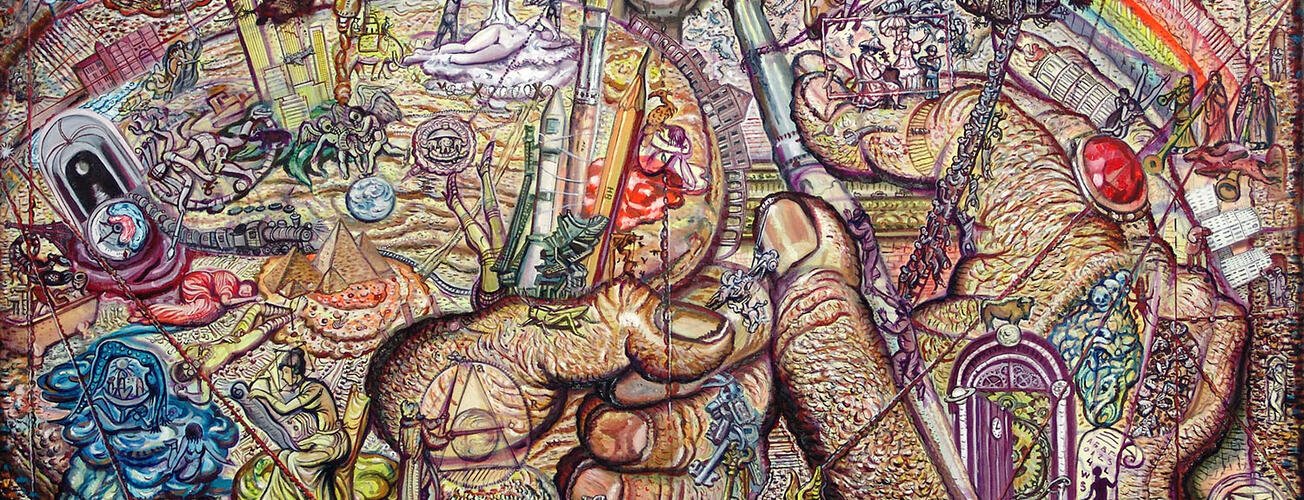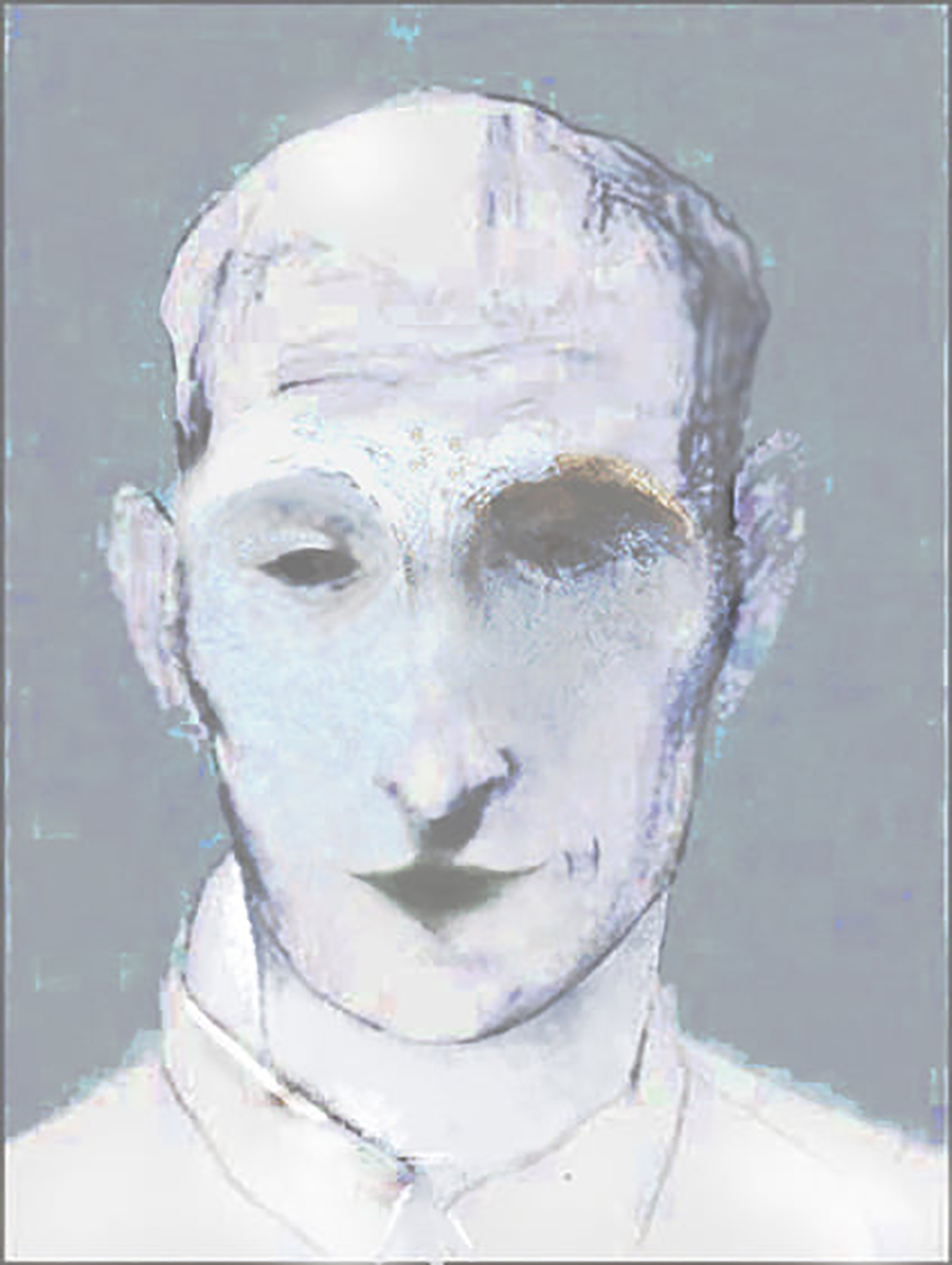
Aleś Rodzin (1947-2022)
often worked at the intersection of arts, engaging in performances and video art, but he truly manifested himself in his paintings, which had rather flexible boundaries. Not because it was difficult to find frames for such large formats, but because each of his works became a temporary and shallow form for content, without exaggerating, encompassing planetary issues that overflowed and embodied themselves in palimpsests and sequences. However, despite his paintings being transboundary, all of the artist's work appears cohesive and synthetic. That's what this person was like.
Various styles and visual vocabularies intertwined in Aleś Rodzin's works: Bosch-like allegories, baroque forms, surrealist intuitions, meticulous details of scientific fiction. The artist intertwined memories of the past and predictions of the future in a typically Rodzin-esque visual stream of images. Here, forms and pre-forms, macro and microcosms of mental, physical, and astral coexistence merge.
The present, the past, and the future blend into a hermetic universe full of apocalyptic predictions. "In art, I am both here and not here, I am everywhere and nowhere," Rodzin said in one interview. "I must be dissolved in everything. An artist must be without skin. He must only live through sensations — then he is a guide. Photons, neurons, and protons pass through him. He lets this divine guidance pass through him, stringing it together, and also creating and making it similar to nothing. Here, everywhere, and nowhere."
"The author describes his creative method quite precisely ― allowing to pass through himself, stringing together, and creating... His painting technique resembles a game of beads. In a vivid compositional framework, Rodzin introduces large forms, then breaks them down into tiny details, deepening and elaborating, creating full-fledged works and fragments.
Positioning oneself as an intermediary between reality and unreality is quite a common artistic self-awareness. Every creator transforms the world in their effort to make their work logical and self-sufficient, regardless of how far they depart from real forms. Rodzin perceived reality as a dream, a flow of various energies. This manifested, on the one hand, in the complex syncretism of his canvases, where technological and organic forms organically coexisted, and on the other hand, in their stylistic similarity. All his works appear as if one giant canvas, despite the distinct composition and color of each creation.

None of this would have been possible without the unique Berlin art house of creators ― the "Tacheles" squat, which existed from 1990 to 2012, where Aleś Rodzin constantly found himself in the flow and this flow passed through him.
Rodzin entered the famous squat in 2000 and immediately understood that this was what he needed. His studio occupied an entire floor there ― about 800 square meters. Berlin continued to inspire Rodzin again and again. Rodzin explained to foreign journalists that he could not create such works anywhere else. The artist became a part of the "Tacheles" space, its symbol, and a permanent performance.

The author spent 15 years in "Tacheles," 13 of which he curated a permanent solo exhibition. A solo exhibition is essentially an open studio, where he placed an easel amidst the space and worked until three in the morning on the next canvas in front of the audience."
"People sometimes came in the thousands per day. Visitors became a barometer of artistic merit, and Rodzin gauged his paintings based on their reactions. Everything that makes up the image — exploration of space, combinations of images, the plastic interrelation of figures and textures — influences the compositional essence of his works, which in turn affects their energetic essence. Rodzin expected his work to have such a powerful energetic impact that it would be impossible for a person to pass by a canvas without stopping. And he observed: whether the work stopped the viewer or not. If a viewer walked past without stopping, the author continued to seek and extract the strength of the painting, delving into its essence.
It is not for nothing that his works are distinctly relief-like and very actively interact with space, influencing it as if sculptures. The author sought to create a new language through compositional and coloristic interaction of structure and texture, spent fifteen years in "Tacheles" searching for his own artistic formula. Each of his paintings from "Tacheles" is a certain image conveyed through the combination of structure and texture. This flow began to captivate the artist, and the more firmly he entered this state, the stronger the internal energy of the artist from the canvas was transmitted to the viewer. Even foreigners — seemingly people with a completely different cultural memory, codes, and surroundings — felt this energetic flow.
Rodzin tried to transfer the spirit of his "Tacheles" to Minsk. No matter how attractive Berlin was to him, Rodzin did not want to move there permanently, did not buy an apartment there, and periodically returned to his homeland. After the collapse of "Tacheles" and the new owners of the building in 2012, he moved to Minsk, working in a workshop that was incredibly small for his canvases, but he did not betray the large format.
Rodzin finally found a place similar to Berlin's "Tacheles" in the Minsk space "Verkh," where one of the "Roof" festivals took place. Also, in the former OK16, Rodzin showed his monumental work "Myth of the Millennium" and created an exhibition inspired by a sacred temple.
Ungoverned in life, this creator was an ascetic of art. He argued that reality is only a dream. Apparently, for Ales Rodzin, true reality was only his art...
The curator of the memorial exhibition is Zmitser Yurkevich, researcher-archivist, columnist for the "Kultura" editorial office, artist-performer.
Праект «Эксперыментальны кантакт» у мінскім Палацы мастацтва, прысвечаны памяці беларускага мастака Алеся Родзіна (1947-2022), працягваецца да 10 сакавіка.








.jpg)




